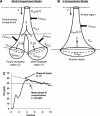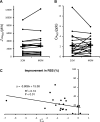Quantifying proximal and distal sources of NO in asthma using a multicompartment model
- PMID: 20093668
- PMCID: PMC2853204
- DOI: 10.1152/japplphysiol.00795.2009
Quantifying proximal and distal sources of NO in asthma using a multicompartment model
Abstract
Nitric oxide (NO) is detectable in exhaled breath and is thought to be a marker of lung inflammation. The multicompartment model of NO exchange in the lungs, which was previously introduced by our laboratory, considers parallel and serial heterogeneity in the proximal and distal regions and can simulate dynamic features of the NO exhalation profile, such as a sloping phase III region. Here, we present a detailed sensitivity analysis of the multicompartment model and then apply the model to a population of children with mild asthma. Latin hypercube sampling demonstrated that ventilation and structural parameters were not significant relative to NO production terms in determining the NO profile, thus reducing the number of free parameters from nine to five. Analysis of exhaled NO profiles at three flows (50, 100, and 200 ml/s) from 20 children (age 7-17 yr) with mild asthma representing a wide range of exhaled NO (4.9 ppb < fractional exhaled NO at 50 ml/s < 120 ppb) demonstrated that 90% of the children had a negative phase III slope. The multicompartment model could simulate the negative phase III slope by increasing the large airway NO flux and/or distal airway/alveolar concentration in the well-ventilated regions. In all subjects, the multicompartment model analysis improved the least-squares fit to the data relative to a single-path two-compartment model. We conclude that features of the NO exhalation profile that are commonly observed in mild asthma are more accurately simulated with the multicompartment model than with the two-compartment model. The negative phase III slope may be due to increased NO production in well-ventilated regions of the lungs.
Figures



Similar articles
-
Effect of heterogeneous ventilation and nitric oxide production on exhaled nitric oxide profiles.J Appl Physiol (1985). 2008 Jun;104(6):1743-52. doi: 10.1152/japplphysiol.01355.2007. Epub 2008 Mar 20. J Appl Physiol (1985). 2008. PMID: 18356478
-
Examining axial diffusion of nitric oxide in the lungs using heliox and breath hold.J Appl Physiol (1985). 2006 Feb;100(2):623-30. doi: 10.1152/japplphysiol.00008.2005. Epub 2005 Oct 6. J Appl Physiol (1985). 2006. PMID: 16210445
-
Clinical patterns in asthma based on proximal and distal airway nitric oxide categories.Respir Res. 2010 Apr 28;11(1):47. doi: 10.1186/1465-9921-11-47. Respir Res. 2010. PMID: 20426813 Free PMC article.
-
Modeling pulmonary nitric oxide exchange.J Appl Physiol (1985). 2004 Mar;96(3):831-9. doi: 10.1152/japplphysiol.00950.2003. J Appl Physiol (1985). 2004. PMID: 14766761 Review.
-
Exhaled nitric oxide and other exhaled biomarkers in bronchial challenge with exercise in asthmatic children: current knowledge.Paediatr Respir Rev. 2015 Jan;16(1):68-74. doi: 10.1016/j.prrv.2013.11.006. Epub 2013 Nov 21. Paediatr Respir Rev. 2015. PMID: 24368252 Review.
Cited by
-
Bayesian estimation of physiological parameters governing a dynamic two-compartment model of exhaled nitric oxide.Physiol Rep. 2017 Aug;5(15):e13276. doi: 10.14814/phy2.13276. Physiol Rep. 2017. PMID: 28774947 Free PMC article.
-
On the importance of statistics in breath analysis--hope or curse?J Breath Res. 2014 Mar;8(1):012001. doi: 10.1088/1752-7155/8/1/012001. Epub 2014 Feb 24. J Breath Res. 2014. PMID: 24565974 Free PMC article.
-
Clinical study of multiple breath biomarkers of asthma and COPD (NO, CO(2), CO and N(2)O) by infrared laser spectroscopy.J Breath Res. 2011 Sep;5(3):037108. doi: 10.1088/1752-7155/5/3/037108. Epub 2011 Jul 15. J Breath Res. 2011. PMID: 21757803 Free PMC article.
-
Nitric oxide in adaptation to altitude.Free Radic Biol Med. 2012 Apr 1;52(7):1123-34. doi: 10.1016/j.freeradbiomed.2011.12.028. Epub 2012 Jan 20. Free Radic Biol Med. 2012. PMID: 22300645 Free PMC article. Review.
References
-
- American Thoracic Society/European Respiratory Society Recommendations for standardized procedures for the online and offline measurement of exhaled lower respiratory nitric oxide and nasal nitric oxide. Am J Respir Crit Care Med 171: 912–930, 2005 - PubMed
-
- American Thoracic Society Lung function testing: selection of reference values, and interpretative strategies. Am Rev Respir Dis 144: 1202–1218, 1991 - PubMed
-
- Alving K, Weitzberg E, Lundberg JM. Increased amount of nitric oxide in exhaled air of asthmatics. Eur Respir J 6: 1368–1370, 1993 - PubMed
-
- Aris R. Elementary Chemical Reactor Analysis. Boston: Butterworths, 1989, p. xii, 352
-
- Bates JH, Rossi A, Milic-Emili J. Analysis of the behavior of the respiratory system with constant inspiratory flow. J Appl Physiol 58: 1840–1848, 1985 - PubMed
Publication types
MeSH terms
Substances
Grants and funding
LinkOut - more resources
Full Text Sources
Medical

